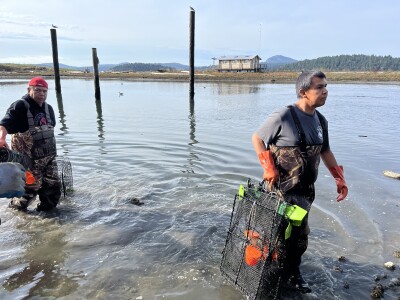Fuel costs eat into narrow margins, and emissions regulations continue to tighten in the commercial fishing world. The idea of electrifying commercial fishing vessels is beginning to float.
But for Paul Nosworthy, owner of New England Marine Engineering and Supply Inc. in New Bedford, Massachusetts, the conversation isn’t just about swapping diesel for batteries; it’s about practicality, power, and the people doing the work.
“It takes a certain amount of power to operate a vessel- between propulsion and auxiliary generator plants,” Nosworthy said. “We attempt to size the generator plant as close to the practical load requirement as possible.”
While full electric propulsion remains hypothetical in New England’s commercial fleet, Nosworthy’s shop is already bridging the gap in quieter ways. “We now install soft start rectifiers on larger motors,” he explained. “It takes three times the running amps to start an electric motor. If a motor draws 30 amps running, it takes 90 amps to start. Using a rectifier, you can maintain the run amp load at startup. We maintain an inventory of these soft starters.”
That kind of upgrade may seem small, but it signals a larger trend- more boats exploring electric auxiliary systems, especially refrigeration, gensets, and potentially winches, before ever considering propulsion.
“Many boats are finding the need to install refrigeration to prevent the loss of their catch,” said Nosworthy. “A lot of smaller vessels have had to upgrade their generator plants. That’s costly. The smoke stack has to be enlarged, and so does the keel cooler.”
These changes trigger a cascade of other requirements: more ventilation, more airflow, and more space. “Engine room ventilation needs to be increased,” he added. “You need 3.5 CFM (Cubic Feet per Minute) for each horsepower of the engine, which allows proper air and fuel mix to get to the cylinders, prolonging engine life and reducing fuel use.
But some boats still miss the basics. “We often find an exhaust fan in the engine room pulling air from the engines,” he said. “There needs to be a hole around the smokestack in the engine room to allow the hot gases to rise, like a chimney at your house. Natural convection. But these guys don’t have the time or money to correct these problems.”
For Nosworthy, the future of electric systems won’t arrive with a retrofit; it’ll come with new builds. “Sure,” he said when asked about Northeast ports being ready to support adoption. “It will most likely have someone to pilot this, usually someone building a new boat. The cost to install this during new construction is far less expensive than retrofitting a 30-year-old vessel.”
This reality echoes the experience of fishermen who have tried to modernize their engines through state and federal funding. According to the Policy Pathways research done by five researchers who came together through the Fishery Friendly Climate Campaign, the EPA Diesel Emissions Reduction Act (DERA), and California’s Carl Moyer Program, success stories often involved newer vessels, outside technical help, or long-term planning.
One West Coast fisherman who received Carl Moyer funding explained, “It was a six-month-long project. If I ever have to do it again, I will sink the boat or go work at McDonald's.”
For others, full electrification remains impractical not because of the technology, but due to logistics. Nosworthy has heard talk about electric ferries on short routes where the boat can recharge between runs, but not so much when it comes to offshore fleets.
“I hear there are some things like electric ferries on short runs where there is an hour for loading and unloading to quick-charge battery banks,” he said. “Hydraulics is a very expensive mover of power. I’ve seen some big electric winches used on U.S. Navy salvage ships.”
The question remains: could electric motors replace those haul back engines and hydraulic winches on commercial fishing boats? “If the haul back engine was a generator large enough to use electric motors on the cargos and main winches, possibly the cargos could run off the hotel gensets,” Nosworthy said. “Will it save more fuel? That will take some intense research, and who is going to build these electric winches?”
Programs like DERA have shown potential to fund parts of this research, but most projects to date have focused on engine repowers rather than full system redesigns. Hopefully, that may change over time. As the DERA report notes, fishermen have recommended expanding the list of qualifying upgrades and simplifying the application process for smaller projects, especially those involving auxiliary systems.
Nosworthy thinks it’ll take more than incentives to move the needles. It’ll take people.
“If I were to help spearhead something like this, get me a couple of Mass Maritime engineers on co-op,” he suggested. “They could help with the research on getting away from hydraulics and going electric with winches. We could do some inspections of vessels, and if there was money to make the modifications, we’d have a lot of stuff.”
His shop, like many others, doesn’t have a dedicated engineering team. “A grant to help get us an in-house staff engineering team to sort out each application would help,” he said. “Each boat is different, but all have the same old gear that’s been the standard for years.”
Manufacturers could play a role, too. Nosworthy was quick to say yes when asked is training, inventory assistance, or demonstration projects would help him feel more confident recommending electric systems.
In California, fishermen who did succeed with the Carl Moyer Program echo the value of that kind of support. One recipient who replaced a diesel engine with a Tier 3 Cummins used help from a former air district employee turned grant writer. “She knows all the ins and outs,” the fisherman said.
Others have had to dip into their savings, retirement funds, or even sell property to make up the match, even when the grant covered 80 to 90 percent of the project cost.
For Nosworthy, those stories sound familiar. “We’re all busy trying to keep our small businesses alive,” he said. “But if someone wants to help us make this real, yes, we’d be part of it.”
While the road to electric fishing gear may not be paved yet, there are folks like Nosworthy ready to help lay the first pipe, as long as someone is willing to fund the wiring.







